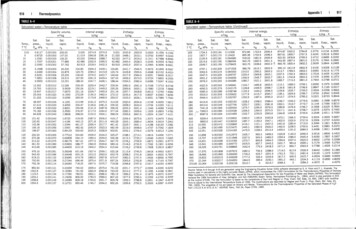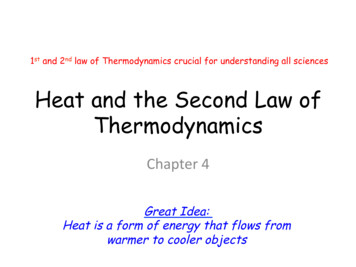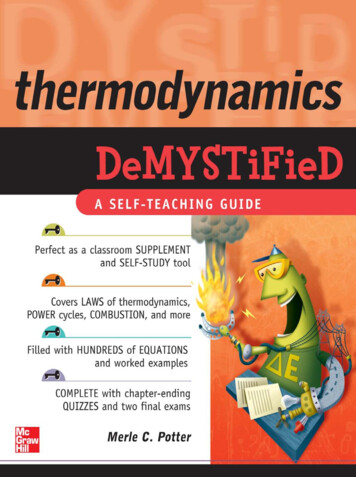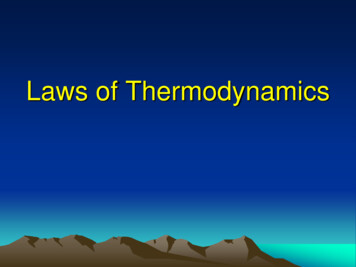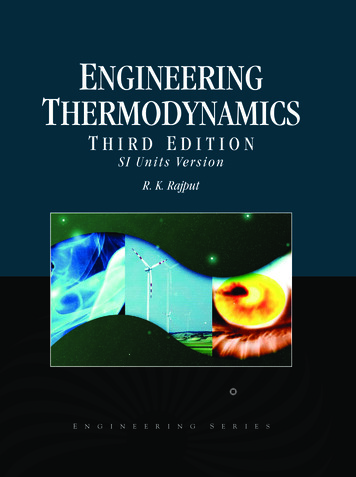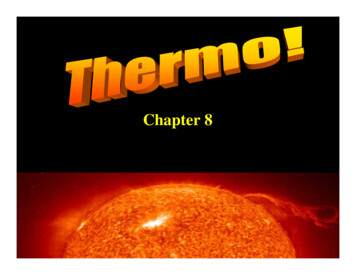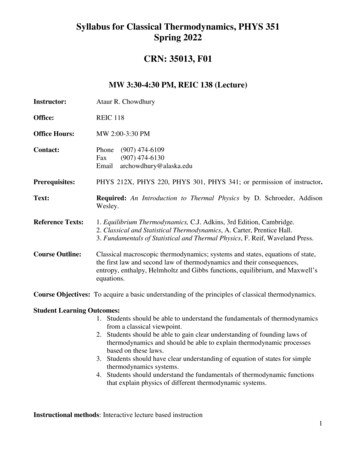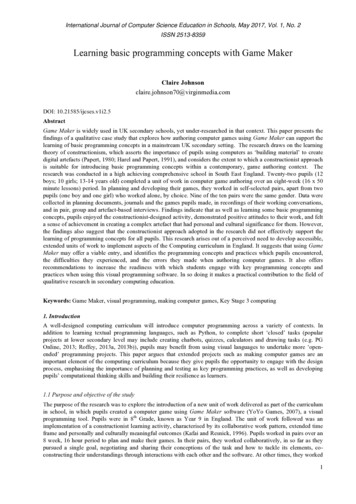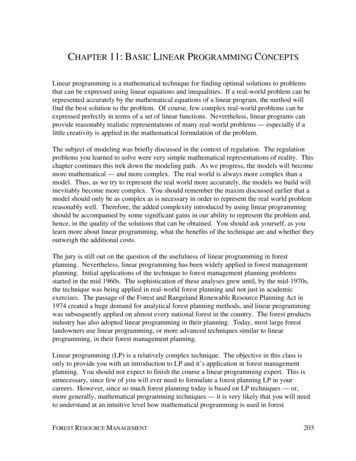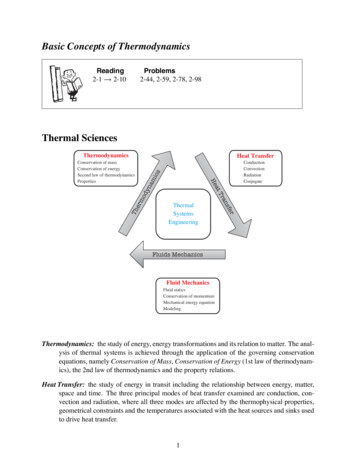
Transcription
Basic Concepts of ThermodynamicsReading2-1 2-10Problems2-44, 2-59, 2-78, 2-98Thermal SciencesHeat rmodynamicsConservation of massConservation of energySecond law of thermodynamicsPropertiesFluids MechanicsFluid MechanicsFluid staticsConservation of momentumMechanical energy equationModelingThermodynamics: the study of energy, energy transformations and its relation to matter. The analysis of thermal systems is achieved through the application of the governing conservationequations, namely Conservation of Mass, Conservation of Energy (1st law of thermodynamics), the 2nd law of thermodynamics and the property relations.Heat Transfer: the study of energy in transit including the relationship between energy, matter,space and time. The three principal modes of heat transfer examined are conduction, convection and radiation, where all three modes are affected by the thermophysical properties,geometrical constraints and the temperatures associated with the heat sources and sinks usedto drive heat transfer.1
Fluid Mechanics: the study of fluids at rest or in motion. While this course will not deal extensively with fluid mechanics we will be influenced by the governing equations for fluid flow,namely Conservation of Momentum and Conservation of Mass.ThermodynamicsMicroscopic: tracking the movement of matter and energy on a particle by particle basisMacroscopic: use the conservation equations (energy and mass) to track movement of matter andenergy on an average over a fixed domain (referred to as classical thermodynamics)Energy the total energy of the system per unit mass is denoted as e and is given ase E kJm kg if we neglect the contributions of magnetic, electric, nuclear energy, we can write the totalenergy asE U KE P E U mV 22 mgzDimensions and UnitsSI: International System SI is the preferred because it is logical (base 10) and needs no correction factors unit convention:ParameterUnitslength, Lmass, mtime, ttemperature, Tvelocity, Vacceleration, aforce, Fenergy, Emeterskilogramssecondskelvinmeter per second, L/tmeter per second squared L/t2newton, m · L/t2joule m · L2 /t22SymbolmkgsKm/sm/s2NJ
Thermodynamic SystemsIsolated BoundarySurroundingsrkWoatSystemSurroundings- everything that interactswith the systemHeSystem- may be as simpleas a melting ice cube- or as complex as anuclear power plantSystem Boundary(real or imaginaryfixed or deformable)SYSTEM:Closed System: composed of a control (or fixed) mass where heat and work can cross theboundary but no mass crosses the boundary.Open System: composed of a control volume (or region in space) where heat, work, andmass can cross the boundary or the control surfaceweightsby-pass flowgfanpistongassystemboundaryengine coreClosed SystemOpen SystemWORK & HEAT TRANSFER: work and heat transfer are NOT properties they are the forms that energy takes tocross the system boundary3
Thermodynamic Properties of SystemsBasic DefinitionsThermodynamic Property: Any observable or measurable characteristic of a system. Any mathematical combination of the measurable characteristics of a systemIntensive Properties: Properties which are independent of the size (or mass) of the system they are not additive XA B XA XB examples include: pressure, temperature, and densityExtensive Properties: Properties which are dependent of the size (or mass) of the system they are additive XA B XA XB examples include: volume, energy, entropy and surface areaSpecific Properties: Extensive properties expressed per unit mass to make them intensive properties specific property (intensive) extensive propertymassMeasurable Properties P, V, T, and m are important because they are measurable quantities. Many other thermodynamic quantities can only be calculated and used in calculations when they are related toP, V, T, and m– Pressure (P ) and Temperature (T ) are easily measured intensive properties.Note: They are not always independent of one another.– Volume (V ) and mass (m) are easily measured extensive propertiesPressure P ressure F orceArea; Nm2 Pa– in fluids, this is pressure (normal component of force per unit area)– in solids, this is stress4
OSPHERICPRESSUREabsolutevacuum pressureabsolutepressureTemperature temperature is a pointer for the direction of energy transfer as heatTA TBTA TBQTATBTAQTB0th Law of Thermodynamics: if system C is in thermal equilibrium with system A,and also with system B, then TA TB TCState and EquilibriumState Postulate how long does the list of intensive properties have to be in order to describe the intensivestate of the system?5
samesubstanceABmB 0.1 kgmA 10 kgT 500 KP 0.1 MPa3v 0.5 m /kgu 3.0 kJ/kg. System A and B have the same intensive state, but totally different extensive states.State Postulate (for a simple compressible system): The state of a simplecompressible system is completely specified by 2 independent and intensive properties. note: a simple compressible system experiences negligible electrical, magnetic, gravitational, motion, and surface tension effects, and only P dV work is done in a single phase system, T, v, and P are independent and intensive (in a multiphase systemhowever, T and P are not independent) if the system is not simple, for each additional effect, one extra property has to be known tofix the state. (i.e. if gravitational effects are important, the elevation must be specified andtwo independent and intensive properties) it is important to be able to:– find two appropriate properties to fix the state– find other properties when the state is fixed (we will discuss this later)Thermodynamic Processes the process is any change from one equilibrium state to another. (If the end state initialstate, then the process is a cycle)6
the process path is a series intermediate states through which a system passes during theprocess (we very seldom care what the process path is) processes are categorized based on how the properties behave:– isobaric (P constant)– isothermal (T constant)– isochoric or isometric (V constant)– isentropic (s constant)– isenthalpic (h constant)– adiabatic (no heat transfer)Stored Energy how is energy stored in matter?Stored Energy E KE P E U Kinetic Energy: Energy due to motion of the matter with respect to an external referenceframe (KE mV 2 /2) Potential Energy: Energy due to the position of the matter in a force field (gravitational,magnetic, electric). It also includes energy stored due to elastic forces and surface tension(P E mgz) Internal Energy microscopic forms of energy, U )– forms of the energy in the matter due to its internal structure (independent of externalreference frames)Transit EnergyHeat transit form of energy that occurs when there is ΔT (a temperature gradient) notation - Q (kJ ), q (kJ/kg), Q̇ (kW ), q̇ (kW/kg)Work transit form of energy that occur due to all other driving forces notation - W (kJ ), w (kJ/kg), Ẇ (kW ), ẇ (kW/kg)7
Properties of Pure SubstancesReading3-1 3-73-9 3-11Problems3-49, 3-52, 3-57, 3-70, 3-75, 3-106,3-121, 3-123Pure Substances a Pure Substance is the most common material model used in thermodynamics.– it has a fixed chemical composition throughout (chemically uniform)– a homogeneous mixture of various chemical elements or compounds can also be considered as a pure substance (uniform chemical composition)– a pure substance is not necessarily physically uniform (different phases)Phases of Pure Substances a pure substance may exist in different phases, where a phase is considered to be a physicallyuniform 3 principal phases:Solids:– strong molecular bonds– molecules form a fixed (but vibrating) structure (lattice)Liquids:– molecules are no longer in a fixed position relative to one another– molecules float about each otherGases:– there is no molecular order– intermolecular forces 0Behavior of Pure Substances (Phase Change Processes) Critical Point: liquid and vapor phases are not distinguishable Triple point: liquid, solid, and vapor phases can exist together1
Psubstances thatcontract on freezingsubstances thatexpand on OLIDLIQUIDcritical pointntiozaoripvavaporizationtriple P0P0GLLSLSdQdQGdQdQTdQcritical pointnesaturatedlr lipovaiquiddatelinetursalinefusionP0GL GLSS Ltriple point lineS Gv2
T v Diagram for a Simple Compressible Substance consider an experiment in which a substance starts as a solid and is heated up at constantpressure until it all becomes as gas depending on the prevailing pressure, the matter will pass through various phase transformations. At P0 :1. solid2. mixed phase of liquid and solid3. sub-cooled or compressed liquid4. wet vapor (saturated liquid-vapor mixture)5. superheated vaporThe Vapor Dome general shape of a P v diagram for a pure substance is similar to that of a T v diagramPcritical pointsubcooledliquidgas (vapor)TcrTtwo-phase region(saturated liquid &saturated vapor)L GPsat(T)Tsaturatedliquid linesaturatedvapor linevfgvgvfv express values of properties for conditions on the vapor dome as:specific volume: vf , vg and vf g vg vfinternal energy: uf , ug and uf g ug ufspecific enthalpy: hf , hg and hf g hg hfspecific entropy: sf , sg and sf g sg sf3
in the two phase region, pressure and temperature cannot be specified independently Psat P (Tsat)Tsat T (Psat)this only holds true under the vapor dome in the two-phase region.The Two-Phase Region Qualityx mgmx mg/m mgmg mftotal mass of mixture m mg mfGmass fraction of the gas x mg /mLmass fraction of the liquid 1-x mf/m1 x mf /mProperties of Saturated Mixtures all the calculations done in the vapor dome can be performed using Tables.– in Table A-4, the properties are listed under Temperature– in Table A-5, the properties are listed under Pressure use if given mixture:1) is saturated, 2) has a quality, 3) liquid & vapor are presentv Vm Vf Vgm mf vf mg vgm vf x(vg vf ) vf x vf gx v vfvf g4 (1 x) vf x vg
Properties of Superheated Vapor superheated vapor is a single phase (vapor phase only).– T and P are independent of each other in the single-phase region– properties are typically calculated as a function of T and PTP 100 kPaLPoT 200 CGL GTsat(P)state: 200 oC and 100 kPaPvProperties of Sub-cooled LiquidTPLL GGP 100 kPaTsat(P)oT 20 CPostate: 20 C and 100 kPav5
can be treated as incompressible (independent of P )v v(T, P ) v v(T ) vf (T )u u(T, P ) u u(T ) uf (T )s s(T, P ) s s(T ) sf (T ) while property values for the sub-cooled liquids are not available as a function of temperatureand pressure, they are available as a function of temperature only. for enthalpy:h(T, P ) u(T, P ) v(T, P )P uf (T ) vf (T )P uf (T ) vf (T )Psat(T ) vf (T )[P Psat(T )] hf (T ) hf (T ) vf (T )[P Psat(T )]Equation of State for Gaseous Pure SubstancesThermodynamic relations are generally given in three different forms:Tables: water (Tables A-4 A-8), R134a (Tables A-11 A-13)Graphs: water (Figures A-9 & A-10), R134a (Figure A-14)Equations: air (Tables A-2 & 3-4) since most gases are highly superheated at atmospheric conditions. This means we have touse the superheat tables – but this can be very inconvenient a better alternative for gases: use the Equation of State which is a functional relationshipbetween P, v, and T (3 measurable properties)Ideal Gases gases that adhere to a pressure, temperature, volume relationshipP v RTorP V mRTreferred to as ideal gases6
– where R is the gas constant for the specified gas of interest (R Ru/M̃ )Ru Universal gas constant, 8.314 kJ/(kmol · K)M̃ molecular wieght (or molar mass) of the gas (see Table A-1)) When is the ideal gas assumption viable?– for a low density gas where: the gas particles take up negligible volume the intermolecular potential energy between particles is small particles act independent of one another– Under what conditions can it be used? low density high temperatures - considerably in excess of the saturation region at very low pressuresReal Gases experience shows that real gases obey the following equation closely:P v ZRT (T and P are in absolute terms)– this equation is used to find the third quantity when two others are known– Z is the compressibility factor– Note: Rair 0.287 kJ/kg · K, RH2 4.124 kJ/kg · K what is the compressibility factor (Z)?– Z charts are available for different gases, but there are generalized Z charts that canbe used for all gases– if we “reduce” the properties with respect to the values at the critical point, i.e.reduced pressure Pr reduced temperature Tr PPcTTc7Pc critical pressureTc critical temperature
Reference Values for u, h, s values of enthalpy, h and entropy, s listed in the tables are with respect to a datum where wearbitrarily assign the zero value. For instance:Tables A-4, A-5, A-6 & A-7: saturated and superheated water - the reference for both hfand sf is taken as 0 C. This is shown as follows:uf (@T 0 C) 0 kJ/kghf (@T 0 C) 0 kJ/kgsf (@T 0 C) 0 kJ/kg · KTables A-11, A-12 & A-13: saturated and superheated R134a - the reference for both hfand sf is taken as 40 C. This is shown as follows:hf (@T 40 C) 0 kJ/kghf (@T 40 C) 0 kJ/kgsf (@T 40 C) 0 kJ/kg · KOthers: sometimes tables will use 0 K as the reference for all tables. While this standardizes the reference, it tends to lead to larger values of enthalpy and entropy.Calculation of the Stored Energy for most of our 1st law analyses, we need to calculate ΔEΔE ΔU ΔKE ΔP E for stationary systems, ΔKE ΔP E 0 in general: ΔKE 12m(V22 V12 ) and ΔP E mg(z2 z1 ) how do we calculate ΔU ?1. one can often find u1 and u2 in the thermodynamic tables (like those examined for thestates of water).2. we can also explicitly relate ΔU to ΔT (as a mathematical expression) by using thethermodynamic properties Cp and Cv .8
Specific Heats: Ideal Gases for any gas whose equation of state is exactlyP v RTthe specific internal energy depends only on temperatureu u(T ) the specific enthalpy is given byh u Pvwhereh(T ) u(T ) RTNote: Since u u(T ), and R is a constant, enthalpy is only a function of temperature. for an ideal gasCv Cp dudTdhdT Cv Cv (T ) only Cp Cp (T ) onlyFrom the equation for enthalpy,RT h(T ) u(T )If we differentiate with respect to TR dhdT dudTR Cp Cv9
the calculation of Δu and Δh for an ideal gas is given asΔu u2 u1 Δh h2 h1 21Cv (t) dT (kJ/kg) 21Cp (t) dT (kJ/kg) to carry out the above integrations, we need to know Cv (T ) and Cp (T ). These are availablefrom a variety of sourcesTable A-2a: for various materials at a fixed temperature of T 300 KTable A-2b: various gases over a range of temperatures 250 K T 1000 KTable A-2c: various common gases in the form of a third order polynomialSpecific Heats: Solids and Liquids solids and liquids are incompressible. (i.e., ρ constant). for solids and liquids it can be shown (mathematically) that for incompressible materials:Cp Cv Cand dQ mCdT Table A-3 gives C for incompressible materials as with ideal gases, for incompressible materials C C(T ) 2Δu 1C(T ) dT Cavg ΔTΔh Δu Δ(P v) Δu vΔP Cavg ΔT vΔP– for solids:Δh Δu Cavg ΔT(vΔP is negligible)– for liquids:If P const, Δh Cavg ΔTIf T const, Δh vΔP (we already used this to do more accuratecalculations in the subcooled region).10
First Law of ThermodynamicsReading4-1 4-65-1 5-5Problems4-19, 4-24, 4-42, 4-61, 4-655-37, 5-67, 5-84, 5-104, 5-120, 5-141, 5-213Control Mass (Closed System)A thermodynamic analysis of a system can be performed on a fixed amount of matter known as acontrol mass or over a region of space, known as a control volume.Conservation of MassConservation of Mass, which states that mass cannot be created or destroyed, is implicitly satisfiedby the definition of a control mass.Conservation of EnergyThe first law of thermodynamics states:Energy cannot be created or destroyed it can only change forms. energy transformation is accomplished through energy transfer as work and/or heat. Workand heat are the forms that energy can take in order to be transferred across the systemboundary. the first law leads to the principle of Conservation of Energy where we can stipulate theenergy content of an isolated system is constant.energy entering energy leaving change of energy within the system1
Sign ConventionThere are many potential sign conventions that can be used.Cengel ApproachHeat Transfer: heat transfer to a system is positive and heat transfer from a system is negative.Work Transfer: work done by a system is positive and work done on a system is negative.Culham ApproachAnything directed into the system is positive, anything directed out of the system is negative.2
Example: A Gas CompressorPerforming a 1st law energy balance: Initial F inal Energy gain W1 2EnergyEnergy Energy loss Q1 2 E1E2A first law balance for a control mass can also be written in differential form as follows:dE δQ δWNote: d or Δ for a change in property and δ for a path functionForms of Energy TransferWork Versus Heat Work is macroscopically organized energy transfer. Heat is microscopically disorganized energy transfer.3
Heat Energy Notation:– Q (kJ ) amount of heat transfer– Q̇ (kW ) rate of heat transfer (power)– q (kJ/kg) - heat transfer per unit mass– q̇ (kW/kg) - power per unit mass modes of heat transfer:– conduction: diffusion of heat in a stationary medium (Chapters 8 & 9)– convection: it is common to include convective heat transfer in traditional heat transferanalysis. However, it is considered mass transfer in thermodynamics. (Chapters 10 &11)– radiation: heat transfer by photons or electromagnetic waves (Chapter 12)Work Energy Notation:– W (kJ ) amount of work transfer– Ẇ (kW ) power– w (kJ/kg) - work per unit mass– ẇ (kW/kg) - power per unit mass work transfer mechanisms in general, are a force acting over a distanceMechanical Work force (which generally varies) times displacement 2W12 1F ds4
Moving Boundary Work compression in a piston/cylinder, where A isthe piston cross sectional area (frictionless) the area under the process curve on a P Vdiagram is proportional to21P dV the work is:– ve for compression– ve for expansion sometimes called P dV work orcompression /expansion workW12 21F ds 21P · A ds 21P dVPolytropic Process: where P V n C examples of polytropic processes include:Isobaric process: if n 0 then P C and we have a constant pressure processIsothermal process: if n 1 then from the ideal gas equation P V RT and P V isonly a function of temperatureIsometric process: if n then P 1/nV C 1/n and we have a constant volumeprocessIsentropic process: if n k Cp /Cv then we have an isentropic process5
Gravitational WorkWork is defined as force through a distance 2W12 1F dsSince in the case of lifting an object, force and displacement are in the same direction, the workwill be positive and by definition positive work is into the system. 2W12 1 2F ds 1 2mg ds 1mg dz integrating from state 1 to state 2 givesW12 mg(z2 z1 ) the potential energy of the system increases with an addition of gravitational work,ΔP E W mg(z2 z1 )Acceleration Work if the system is accelerating, the work associated with the change of the velocity can becalculated as follows: 2W12 1 2F ds 1 2ma ds 1mdVdt 2ds 1m dVdsdt Vand we can then write 2W12 1mV dV mV222 V12 2 if we drop an object with the assistance of gravity, the first law balance givesΔP E ΔKE 0. Potential energy decreases and kinetic energy increases.6
Charge Transfer Work (Electrical Work) current, I is the rate of charge transferI d q dtcoulomb,sec Amperewhereq N ewith N being the number of electrons and e the charge of the electron. the electrical work done is given asδWe ( 1 2 ) dq dq where is the electrical potential difference with units volt the electrical work done per unit time is powerẆe P ower δWedt I (W ) 2We 1 I dt IΔt7J ouleCoulomb
Control Volume (Open System)The major difference between a Control Mass and and Control Volume is that mass crosses thesystem boundary of a control volume.CONSERVATION OF MASS:Unlike a control mass approach, the control volume approach does not implicitly satisfyconservation of mass, therefore we must make sure that mass is neither created nor destroyedin our process.m OUTm cvm INcv rate of increase net rate of net rate of of mass withinmass f lowmass f low the CVINOU Tddt(mCV ) ṁIN ṁOUTwhere: mCV Vρ dVṁIN (ρ V A)INṁOUT (ρ V A)OUTwith V average velocity8
CONSERVATION OF ENERGY:The 1st law states:ECV (t) δQ δWshaf t (ΔEIN ΔEOUT ) (δWIN δWOUT ) ECV (t Δt)where:ΔEIN eIN ΔmINΔEOUT eOUT ΔmOUTδW flow worke Em u internalV22 kinetic9 gz potential(1)
What is flow work?This is the work required to pass the flow across the system boundaries. When mass enters/leavesa control volume, some work is done on/by the control volume. volume ΔmIN ρIN AIN VIN ΔtδWIN F · distance PIN AIN · VIN Δt F ΔsPIN ΔmINρINwithv 1ρδWIN (P v Δm)IN flow work(2)Similarly(3)δWOUT (P v Δm)OUT10
Substituting Eqs. 2 and 3 into Eq. 1 gives the 1st law for a control volumeECV (t Δt) ECV (t) δQ δWshaf t ΔmIN (e P v)IN ΔmOUT (e P v)OUT(4)Equation 4 can also be written as a rate equation divide through by Δt and take the limit asΔt 0ddtECV Q̇ Ẇshaf t [ṁ(e P v)]IN [ṁ(e P v)]OUTwhere:ṁ ρ v ANote that:e Pv u Pv (v )22 gz h(enthalpy) KE P EBy using enthalpy instead of the internal energy to represent the energy of a flowing fluid, one doesnot need to be concerned with the flow work.11
Some Practical Assumptions for Control VolumesSteady State Process: The properties of the material inside the control volume do not changewith time. For exampleP2 P1P1Diffuser: P changes inside the control volume, butthe pressure at each point does not change withtime.P2V2 V1Steady Flow Process: The properties of the material crossing the control surface do not changewith time. For exampleT T(y)Inlet Pipe: T at the inlet may be different at different locations, but temperature at each boundarypoint does not change with time.T T(t)yxThe steadiness refers to variation with respect to time if the process is not steady, it is unsteady or transient often steady flow implies both steady flow and steady stateUniform State Process: The properties of the material inside the control volume are uniform andmay change with time. For exampleot 0o50 C50 Co50 oC50 CHeating Copper: Cu conducts heat well, so that itheats evenly.Qt 10o60 C60 oCo60 C60 oC12
Uniform Flow Process: The properties of the material crossing the control surface are spatiallyuniform and may change with time. For exampleP P(y)Inlet Pipe: P at the inlet is uniformacross y.yxUniformity is a concept related to the spatial distribution. If the flow field in a process is notuniform, it is distributed.Steady-State, Steady-Flow ProcessIdealizations: the control volume does not move relative to the reference frame the state of the mass at each point with the control volume does not change with time the flows in and out of the control volume are steady, i.e. there is no mass accumulationwithin the control volume the rates at which work and heat cross the control volume boundary remain constant13
Control Volume Analysis for Electrical DevicesWe recall from the 1st law for a control volumedEcvdt Q̇ Ẇ ṁin(e P v)in ṁout(e P v)outWe can consider the following analogyLetNq N q mqN mqṄ mq number of charged particles ve charge on each particletotal chargemass of each charged particletotal mass of the “charge gas”flow rate of the “charge gas”electrical potential ṁ(e P v) (Ṅ mq ) u Pv V22negligible (N q ) gz (Nm)q electrical potential per unit mass ṁ(e P v) (Ṅ mq(N q ) (N mq )14
Ṅ q I where I current Ṅ q Ṅ eThe first law takes the formdEcvdt Q̇ Ẇ (Ṅ q )in (Ṅ q )out15
Entropy and the Second Law of ThermodynamicsReading6-1, 6-2, 6-7, 6-8, 6-117-1 7-10, 7-12, 7-13Problems6-81, 6-87,7-39, 7-46, 7-61, 7-89, 7-111,7-122, 7-124, 7-130, 7-155, 7-158Why do we need another law in thermodynamics?Answer: While the 1st law allowed us to determine the quantity of energy transfer in a processit does not provide any information about the direction of energy transfer nor the quality ofthe energy transferred in the process. In addition, we can not determine from the 1st lawalone whether the process is possible or not. The second law will provide answers to theseunanswered questions.A process will not occur unless it satisfies both the first and the second laws of thermodynamics.1. Direction:Consider an isolated system where Q W 0From the 1st law we know same both ways1 2 2 1(U KE)1 U2 E1E2possiblegasimpossible1: cold systempropeller &gas rotatinggas2: warm systempropeller &gas stationaryThe physical interpretation of this is:1
State 1: Most of the energy is in a highly organized form residing in the macroscopic KEof the propeller and the rotating gas.State 2: All of the energy is now in a disorganized form residing in the microscopic E, i.e.U of the propeller and the gas. The process 1 2 has resulted in a higher state of molecular chaos. EN T ROP Y isthe thermodynamic property that describes the degree of molecular disorder in matter.Hence, S2 S1 . Entropy can be considered a quantitative index that describes thequality of energy. The process 2 1 is impossible because it would require disorganized KE to produce macroscopically organized KE. That is S2 S1 which is impossible for anisolated system. A thermodynamic process is only possible if it satisfies both the 1st and 2nd lawssimultaneously.2. Quality of Energy:A heat engine produces reversible work as it transfers heat from a high temperature reservoirat TH to a low temperature reservoir at TL . If we fix the low temperature reservoir atTL 300 K, we can determine the relationship between the efficiency of the heat engine,η 1 QLQH 1 TLTHas the temperature of the high temperature reservoir changes. In effect we are determining the quality of the energy transferred at high temperature versus that transferred at lowtemperature.THQHreversibleheat engineWrevQLTL2
TL (K) TH Since the purpose of the heat engine is to convert heat energy to work energy, we can clearlysee that more of the high temperature thermal energy can be converted to work. Thereforethe higher the temperature, the higher the quality of the energy.Second Law of ThermodynamicsThe second law of thermodynamics states:The entropy of an isolated system can never decrease. When an isolated systemreaches equilibrium, its entropy attains the maximum value possible under theconstraints of the systemDefinitionPS Sgen S2 S1 0 2nd law the 2nd law dictates why processes occur in a specific direction i.e., Sgen cannot be ve The second law states, for an isolated system:(ΔS)system (ΔS)surr. 0where Δ f inal initialGibb’s EquationFrom a 1st law energy balance when KE and PE are neglectedEnergy Input Energy Output Increase in Energy Storage3
δQ δW dU (1)dif f erentialamountWe know that the differential form of entropy isdS δQ(2)TδW P dV(3)Combining Eqs. 1, 2 and 3dS dUT P dVT ds du P dvT T per unit mass2nd Law Analysis for a Closed System (Control Mass)MERTERTTERdQdWCMWe can first perform a 1st law energy balance on the system shown above.dU δQ δW(1)For a simple compressible systemδW P dV(2)From Gibb’s equation we knowTT ER dS dU P dV(3)4
Combining (1), (2) and (3) we getTT ER dS δQTherefore(dS)CM storageδQT T ER entropy f lowdP S productionIntegrating gives(S2 S1 )CM Q1 2TT ER Sgen 0whereQ1 2TT ER- the entropy associated with heat transfer across afinite temperature difference, i.e. T 05
2nd Law Analysis for Open Systems (Control Volume)S AS -dQ 1-2A-s Am1-2ATTERTERFRAAAmAdQ 1-21-2S 0dW1-2MERSCVCVmBBdQ 1-21-2BTERFRBBS sBm1-2BS dQ1-2BTTERisolated Sgen 0δSgen (ΔS)sys (ΔS)sur δSgen ΔS CV system sA mA1 2 sB m B1 2 δQA1 2TTAER δQB1 2TTBERsurroundingsor as a rate equation Ṡgen dSdt sṁ CVQ̇TT ER sṁ OUTThis can be thought of asgeneration accumulation OU T IN6Q̇TT ER IN
Reversible ProcessExample: Slow adiabatic compression of a gasA process 1 2 is said to be reversible if the reverse process 2 1 restores the system to itsoriginal state without leaving any change in either the system or its surroundings. idealization where S2 S1 Sgen 0T2 T1 increased microscopic disorderV2 V1 reduced uncertainty about the whereabouts of moleculesP rocessReversible Adiabatic P rocess Isentropic Sgen 0Q 0S1 S27
Calculation of Δs in ProcessesT1process path2dA T dsdss the area under the curve on a T s diagram is the heat transfer for internally reversibleprocesses 2qint,rev 1T dsandqint,rev,isothermal T ΔsTabulated Calculation of Δs for Pure SubstancesCalculation of the Properties of Wet Vapor:Use Tables A-4 and A-5 to find sf , sg and/or sf g for the followings (1 x)sf xsgs sf xsf gCalculation of the Properties of Superheated Vapor:Given two properties or the state, such a
absolute pressure gauge pressure vacuum pressure absolute vacuum pressure ABSOLUTE ATMOSPHERIC PRESSURE Pressure P atm Temperature temperature is a pointer for the direction of energy transfer as heat QQ T A T A T A T A T B T B T B T B 0th Law of Thermodynamics: if system C is in the
